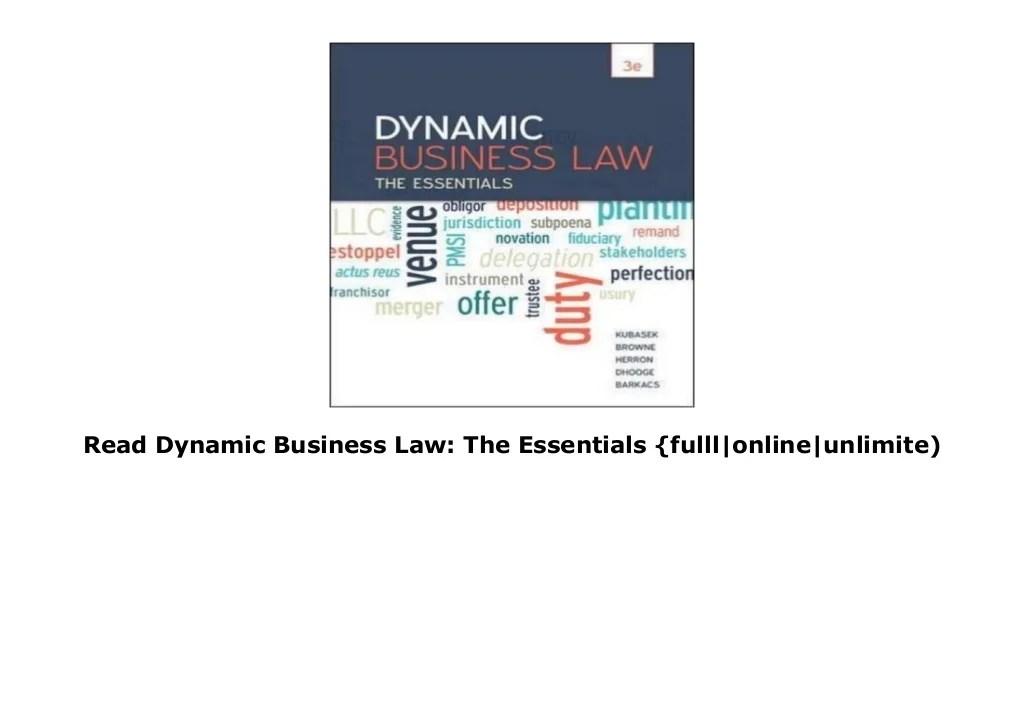Dynamic business law the essentials 5th edition pdf – In this era of dynamic business, “Dynamic Business Law: The Essentials, 5th Edition” stands as an authoritative guide, providing a comprehensive overview of the legal landscape that shapes modern business practices. This esteemed textbook delves into the fundamental principles and concepts of contract law, tort law, property law, business organizations, and business ethics, empowering readers with the knowledge and insights necessary to navigate the complexities of the business world.
As we delve into the intricacies of contract law, we explore the elements that constitute a valid contract, the various types of contracts, and the rights and obligations that bind parties to an agreement. We examine the consequences of breach of contract and the remedies available to aggrieved parties, gaining a deeper understanding of the legal framework that governs business transactions.
1. Introduction
Dynamic business law encompasses the ever-changing legal framework that governs business activities in the modern landscape. It addresses the legal implications of emerging technologies, globalization, and evolving societal norms, providing a comprehensive understanding of the legal environment businesses operate within.
The textbook “Dynamic Business Law: The Essentials, 5th Edition” offers a comprehensive overview of key concepts and principles in this field, including contract law, tort law, property law, business organizations, and business ethics and social responsibility.
2. Contract Law: Dynamic Business Law The Essentials 5th Edition Pdf

Contract law establishes the legal framework for agreements between parties. It defines the elements of a valid contract, such as offer, acceptance, consideration, capacity, and legality, and Artikels the different types of contracts, including express, implied, and quasi-contracts.
Rights and Obligations
- Rights of parties include the right to performance, the right to damages for breach, and the right to rescission.
- Obligations of parties include the duty to perform, the duty to mitigate damages, and the duty to act in good faith.
Breach of Contract and Remedies
Breach of contract occurs when one party fails to fulfill their obligations under the contract. Remedies for breach include compensatory damages, specific performance, and injunctions.
Impact on Business Transactions
Contract law plays a crucial role in business transactions, ensuring the enforceability of agreements and protecting the rights of parties involved.
3. Tort Law
Tort law provides legal recourse for individuals who have suffered harm due to the wrongful acts or negligence of others. Torts encompass a wide range of civil wrongs, including negligence, intentional torts, and strict liability.
Elements of a Tort Claim
- Duty of care
- Breach of duty
- Causation
- Damages
Defenses to Tort Claims
- Contributory negligence
- Assumption of risk
- Statute of limitations
Impact on Businesses
Tort law significantly impacts businesses, as it holds them liable for harm caused by their actions or omissions.
4. Property Law
Property law governs the rights and interests in property, including real property (land and buildings), personal property (movable goods), and intellectual property (intangible creations). It establishes the legal framework for acquiring, using, and transferring property.
Types of Property Rights
- Ownership
- Possession
- Liens
- Easements
Property Disputes and Resolution, Dynamic business law the essentials 5th edition pdf
Property disputes often arise over ownership, boundaries, and easements. These disputes are typically resolved through negotiation, mediation, or litigation.
5. Business Organizations
Business organizations provide a legal framework for conducting business activities. The most common types of business organizations include sole proprietorships, partnerships, corporations, and limited liability companies (LLCs).
Advantages and Disadvantages
| Organization Type | Advantages | Disadvantages |
|---|---|---|
| Sole Proprietorship |
|
|
| Partnership |
|
|
| Corporation |
|
|
| Limited Liability Company (LLC) |
|
|
Real-World Examples
Various business organizations are used in different industries and contexts. For example, sole proprietorships are common in small businesses, partnerships in professional services, corporations in large-scale enterprises, and LLCs in real estate and technology.
6. Business Ethics and Social Responsibility
Business ethics and social responsibility encompass the ethical and societal obligations of businesses. They address issues such as environmental protection, employee rights, consumer protection, and corporate governance.
Legal Framework
The legal framework for enforcing ethical and responsible business practices includes statutes, regulations, and case law.
Examples of Ethical Behavior
- Adhering to environmental regulations
- Providing fair wages and benefits to employees
- Protecting consumer privacy and safety
- Promoting diversity and inclusion
Impact on Businesses
Businesses that demonstrate ethical and responsible behavior often gain a competitive advantage, enhance their reputation, and attract loyal customers and employees.
Essential Questionnaire
What are the key elements of a valid contract?
Offer, acceptance, consideration, capacity, and legality.
What are the different types of torts?
Intentional torts, negligence, and strict liability.
What are the main types of business organizations?
Sole proprietorships, partnerships, corporations, and limited liability companies.